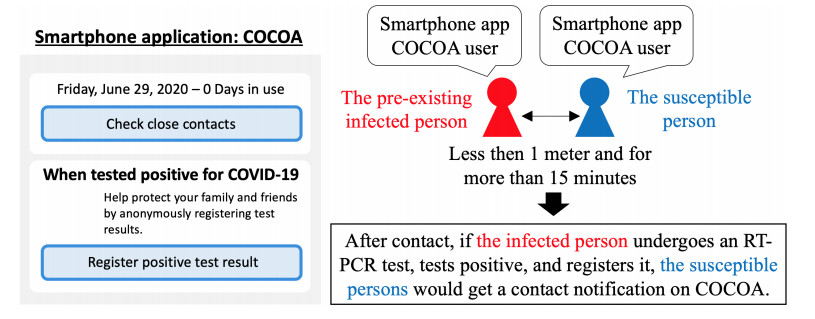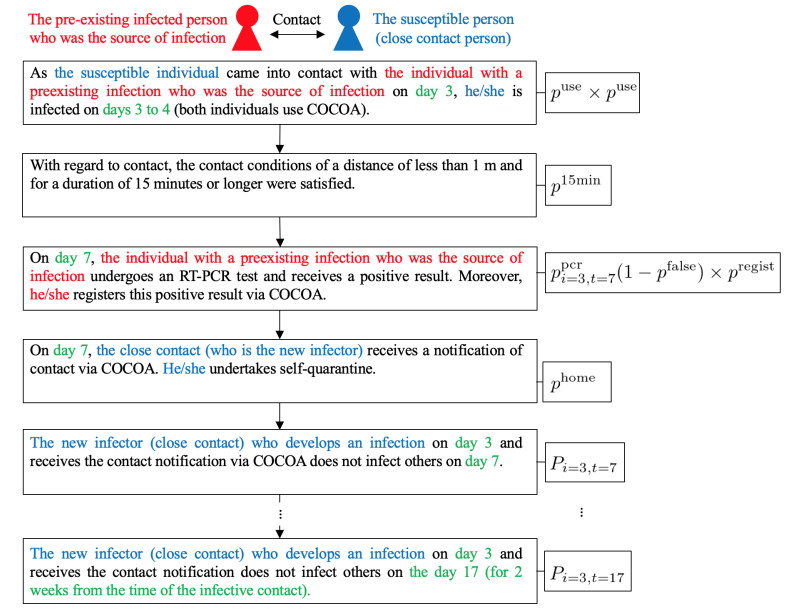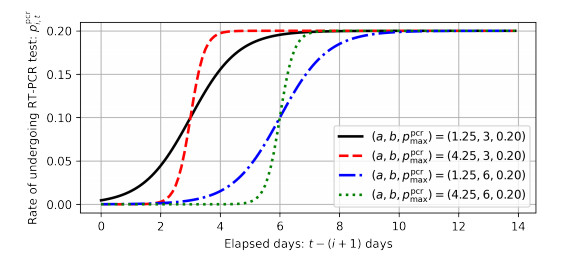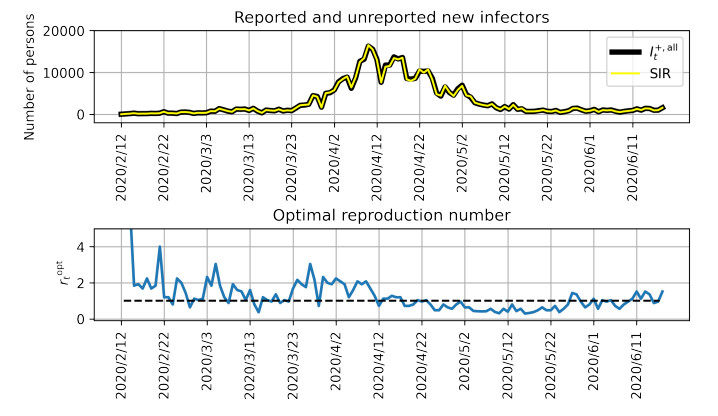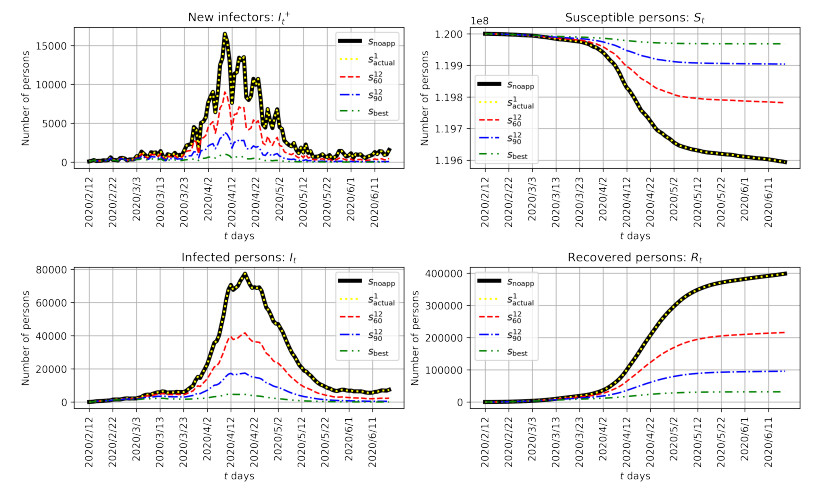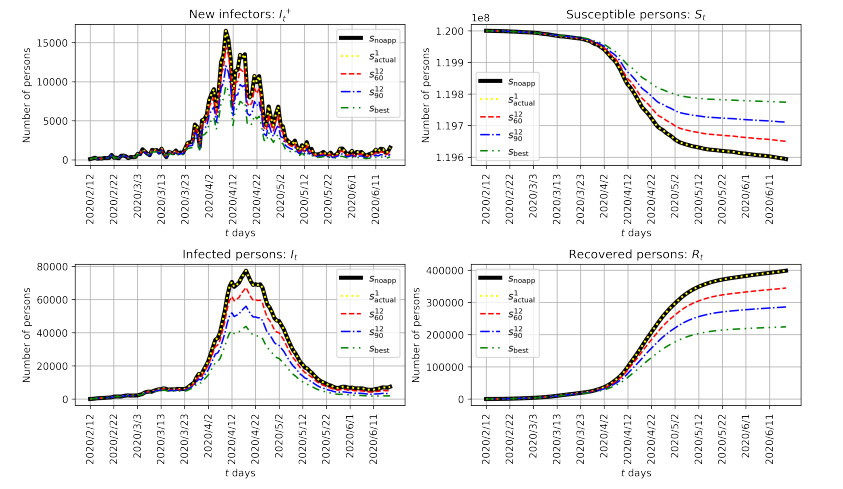|
[1]
|
Ministry of Health, Labour, and Welfare, Request to install the COVID-19 contact-confirming application (COCOA) 2021, Available from: https://www.mhlw.go.jp/content/10900000/000773753.pdf.
|
|
[2]
|
Department of Health and Social Care, NHS. NHS COVID-19 App 2020, Available from: https://www.nhsx.nhs.uk/covid-19-response/nhs-covid-19-app/.
|
|
[3]
|
Anti-Covid-19 Tech Team, Trends in each country regarding the introduction of contact confirmation applications, 2020, Available from: https://cio.go.jp/sites/default/files/uploads/documents/techteam_20200508_02.pdf
|
|
[4]
|
F. Yang, Q. Yang, X. Liu, P. Wang, SIS evolutionary game model and multi-agent simulation of an infectious disease emergency, Technol. Health Care, 23 (2015), 603–613. doi: 10.3233/THC-150999

|
|
[5]
|
J. B. Dunham, An agent-based spatially explicit epidemiological model in MASON, J. Artif. Soc. Social Simul., 9 (2005).
|
|
[6]
|
H. Hirose, Pandemic simulations by MADE: A combination of multi-agent and differential equations, with a novel influenza a (H1N1) case, Information, 16 (2013), 5365–5390.
|
|
[7]
|
D. Chumachenko, V. Dobriak, M. Mazorchuk, I. Meniailov, K. Bazilevych, On agent-based approach to influenza and acute respiratory virus infection simulation, 14th International Conference on Advanced Trends in Radioelectronics, Telecommunications, and Computer Engineering, (2018), 192–195, doi: 10.1109/TCSET.2018.8336184
|
|
[8]
|
C. Hou, J. Chen, Y. Zhou, L. Hua, J. Yuan, S. He, et al., The effectiveness of quarantine in Wuhan city against coronavirus disease 2019 (COVID-19): a well-mixed SEIR model analysis, J. Med. Virol, 92 (2020), 841–848, doi: 10.1002/jmv.25827 doi: 10.1002/jmv.25827

|
|
[9]
|
B. Prasse, M. A. Achterberg, L. Ma, P. V. Mieghem, Network-inference-based prediction of the COVID-19 epidemic outbreak in the Chinese province Hubei, Appl. Network Sci., 5 (2020), doi: 10.1007/s41109-020-00274-2 doi: 10.1007/s41109-020-00274-2

|
|
[10]
|
Q. Yang, C. Yi, A. Vajdi, L. W. Cohnstaedt, H. Wu, X. Guo, et al., Short-term and long-term mitigation evaluations for the COVID-19 epidemic in Hubei province, China, Infect. Dis. Modell., 5 (2020), 563–574. doi: 10.1016/j.idm.2020.08.001

|
|
[11]
|
K. Chatterjee, K. Chatterjee, A. Kumar, S. Shankar, Healthcare impact of COVID-19 epidemic in India: a stochastic mathematical model, Med. J. Armed Forces India, 76 (2020), 147–155. doi: 10.1016/j.mjafi.2020.03.022

|
|
[12]
|
M. A. Achterberg, B. Prasse, L. Ma, S. Trajanovski, M. Kitsak, P. V. Mieghem, Comparing the accuracy of several network-based COVID-19 prediction algorithms, Int. J. Forecast., (2020), doi: 10.1016/j.ijforecast.2020.10.001
|
|
[13]
|
Z. Liu, P. Magal, G. Webb, Predicting the number of reported and unreported cases of COVID-19 epidemics in China, South Korea, Italy, France, Germany, and the United Kingdom, J. Theor. Biol, 509 (2020), doi: 10.1016/j.jtbi.2020.110501 doi: 10.1016/j.jtbi.2020.110501

|
|
[14]
|
E. A. Iboi, O. Sharomi, C. N. Ngonghala, A. B. Gumel, Mathematical modeling and analysis of COVID-19 pandemic in Nigeria, Math. Biosci. Eng., 17 (2020), 7192–7220, doi: 10.3934/mbe.2020369 doi: 10.3934/mbe.2020369

|
|
[15]
|
H. Wang, N. Yamamoto, Using a partial differential equation with Google Mobility data to predict COVID-19 in Arizona, Math. Biosci. Eng., 17 (2020), 4891–4904, doi: 10.3934/mbe.2020266 doi: 10.3934/mbe.2020266

|
|
[16]
|
S. Wang, Y. Liu, T. Hu, Examining the change of human mobility adherent to social restriction policies and its effect on COVID-19 cases in Australia, Int. J. Environ. Res. Public Health, 17 (2020), doi: 10.3390/ijerph17217930 doi: 10.3390/ijerph17217930

|
|
[17]
|
C. Zeng, J. Zhang, Z. Li, X. Sun, B. Olatosi, S. Weissman, X. Li, Spatial-temporal relationship between population mobility and COVID-19 outbreaks in South Carolina: time series forecasting analysis, J. Med. Internet Res., 23 (2021), doi:10.2196/27045 doi: 10.2196/27045

|
|
[18]
|
M. Sulyokab, M. D. Walker, Mobility and COVID-19 mortality across Scandinavia: A modeling study, Travel Med. Infect. Dis., 41 (2021), doi: 10.1016/j.tmaid.2021.102039 doi: 10.1016/j.tmaid.2021.102039

|
|
[19]
|
I. F. F. dos Santos, G. M. A. Almeida, F. A. B. F. de Moura, Adaptive SIR model for propagation of SARS-CoV-2 in Brazil, Phys. A, 569 (2021), doi: 10.1016/j.physa.2021.125773 doi: 10.1016/j.physa.2021.125773

|
|
[20]
|
I. F. F. dos Santos, G. M. A. Almeida, F. A. B. F. de Moura, Evolution of SARS-CoV-2 in the state of Alagoas-Brazil via an adaptive SIR model, Int. J. Mod. Phys. C, 32 (2021), doi: 10.1142/S0129183121500406 doi: 10.1142/S0129183121500406

|
|
[21]
|
M. Niwa, Y. Hara, S. Sengoku, K. Kodama, Effectiveness of social measures against COVID-19 outbreaks in several Japanese regions analyzed by system dynamic modeling, SSRN 3653579 (2020), doi: 10.2139/ssrn.3653579
|
|
[22]
|
S. Kurahashi, Estimating effectiveness of preventing measures for 2019 novel coronavirus diseases (COVID-19), Trans. Jpn. Soc. Artif. Intell., 35 (2020), D-K28-1, doi: 10.1527/tjsai.D-K28 doi: 10.1527/tjsai.D-K28

|
|
[23]
|
G. L. Vasconcelos, A. M. S. Macêdo, G. C. Duarte-Filho, A. A. Brum, R. Ospina, F. A. G. Almeida, Power law behaviour in the saturation regime of fatality curves of the COVID-19 pandemic, Sci. Rep., 11 (2021), article number: 4619, doi: 10.1038/s41598-021-84165-1 doi: 10.1038/s41598-021-84165-1

|
|
[24]
|
A. M. S. Macêdo, A. A. Brum, G. C. Duarte-Filho, F. A. G. Almeida, R. Ospina, G. L. Vasconcelos, A comparative analysis between a SIRD compartmental model and the Richards growth model, medRxiv, doi: 10.1101/2020.08.04.20168120
|
|
[25]
|
R. Hinch, W. Probert, A. Nurtay, M. Kendall, C. Wymant, M. Hall, et al., Effective configurations of a digital contact tracing app: a report to NHSX, 2020. Available from: https://045.medsci.ox.ac.uk/files/files/report-effective-app-configurations.pdf.
|
|
[26]
|
E. Hernandez-Orallo, P. Manzoni, C. T. Calafate, J. C. Cano, Evaluating how smartphone contact tracing technology can reduce the spread of infectious diseases: The case of COVID-19, IEEE Access, 8 (2020), 99083–99097. doi: 10.1109/ACCESS.2020.2998432

|
|
[27]
|
M. E. Kretzschmar, G. Rozhnova, M. C. J. Bootsma, M. Boven, J. H. H. M. Wijgert, M. J. M. Bonten, Impact of delays on effectiveness of contact tracing strategies for COVID-19: A modeling study, Lancet Public Health, 5 (2020), e452–e459. doi: 10.1016/S2468-2667(20)30157-2

|
|
[28]
|
J. A. Kucharski, P. Klepac, A. J. K. Conlan, S. M. Kissler, M. L. Tang, H. Fry, et al., Effectiveness of isolation, testing, contact tracing, and physical distancing on reducing transmission of SARS-CoV-2 in different settings: A mathematical modeling study, Lancet Infect. Dis., 20 (2020), 1151–1160. doi: 10.1016/S1473-3099(20)30457-6

|
|
[29]
|
L. Ferretti, C. Wymant, M. Kendall, L. Zhao, A. Nurtay, L. Abeler-Dorner, et al., Quantifying SARS-CoV-2 transmission suggests epidemic control with digital contact tracing, Science, 368 (2020), doi: 10.1126/science.abb6936 doi: 10.1126/science.abb6936

|
|
[30]
|
Y. Omae, J. Toyotani, K. Hara, H. Takahashi, Effectiveness of COVID-19 contact-confirming application (COCOA) based on a multi-agent simulation, preprint, arXiv: 2008.13166.
|
|
[31]
|
J. Kurita, T. Sugawara, Y. Ohkusa, Effectiveness of COCOA, a COVID-19 contact notification application, in Japan, preprint, medRxiv (2020) doi: 10.1101/2020.07.11.20151597
|
|
[32]
|
G. Kobayashi, S. Sugasawa, H. Tamae, T. Ozu, Predicting intervention effect for COVID-19 in Japan: State space modeling approach, Biosci. Trends, 14 (2020), 174–181, doi: 10.5582/bst.2020.03133 doi: 10.5582/bst.2020.03133

|
|
[33]
|
M. S. Boudrioua, A. Boudrioua, Predicting the COVID-19 epidemic in algeria using the SIR model, preprint, medrxiv (2020) doi: 10.1101/2020.04.25.20079467
|
|
[34]
|
B. Malavika, S. Marimuthu, M. Joy, A. Nadaraj, E. S. Asirvatham, L. Jeyaseelan, Forecasting COVID-19 epidemic in India and high incidence states using SIR and logistic growth models, Clin. Epidemiol. Glob. Health, 9 (2020), 26–33.
|
|
[35]
|
I. Cooper, A. Mondal, C. G. Antonopoulos, A SIR Model Assumption for the spread of COVID-19 in different communities, Chaos Solitons Fractals, 139 (2020), doi: 10.1016/j.chaos.2020.110057 doi: 10.1016/j.chaos.2020.110057

|
|
[36]
|
G. Nakamura, B. Grammaticos, M. Badoual, Confinement strategies in a simple SIR Model, Regul. Chaot. Dyn., 25 (2020), 509–521. doi: 10.1134/S1560354720060015

|
|
[37]
|
M. Itakura, M. Asahi, T. Yamaguchi, Proposal of an infection model for foot-and-mouth disease epidemic, Oper. Res. Manag. Sci. Res., 56 (2011), 728–734, Available from: http://www.orsj.or.jp/archive2/or56-12/or56-12_728.pdf
|
|
[38]
|
H. Nishiura, H. Inaba, Prediction of infectious disease outbreak with particular emphasis on statistical issues using the transmission model, Proc. Inst. Stat. Math., 54 (2006), 461–480, Available from: https://www.ism.ac.jp/editsec/toukei/pdf/54-2-461.pdf
|
|
[39]
|
T. Tsuchiya, A study on the spread of new coronavirus infections, Commun. Oper. Res. Soc. Jpn., 66 (2021), 90–103, doi: 10.24545/00001758 doi: 10.24545/00001758

|
|
[40]
|
Ministry of Health, Labour, and Welfare, Open data of positive result of COVID-19, 2021, Available from: https://www.mhlw.go.jp/content/pcr_positive_daily.csv.
|
|
[41]
|
Ministry of Health, Labour, and Welfare, COVID-19 Contact-Confirming Application (COCOA), 2020, Available from: https://www.mhlw.go.jp/stf/seisakunitsuite/bunya/cocoa_00138.html.
|
|
[42]
|
L. M. Kucirka, S. A. Lauer, O. Laeyendecker, D. Boon, J. Lessler, Variation in false-negative rate of reverse transcriptase polymerase Chain reaction-based SARS-CoV-2 tests by time since exposure, Ann. Intern. Med., 173 (2020), 262–267. doi: 10.7326/M20-1495

|
|
[43]
|
Python 3.7.3, 2019, Available from: https://www.python.org/downloads/release/python-373/
|
|
[44]
|
Numpy, 2021, Available from: https://numpy.org
|
|
[45]
|
E. B. Postnikov, Estimation of COVID-19 dynamics "on a back-of-envelope": Does the simplest SIR model provide quantitative parameters and predictions?, Chaos Solitons Fractals, 135 (2020), doi: 10.1016/j.chaos.2020.109841
|
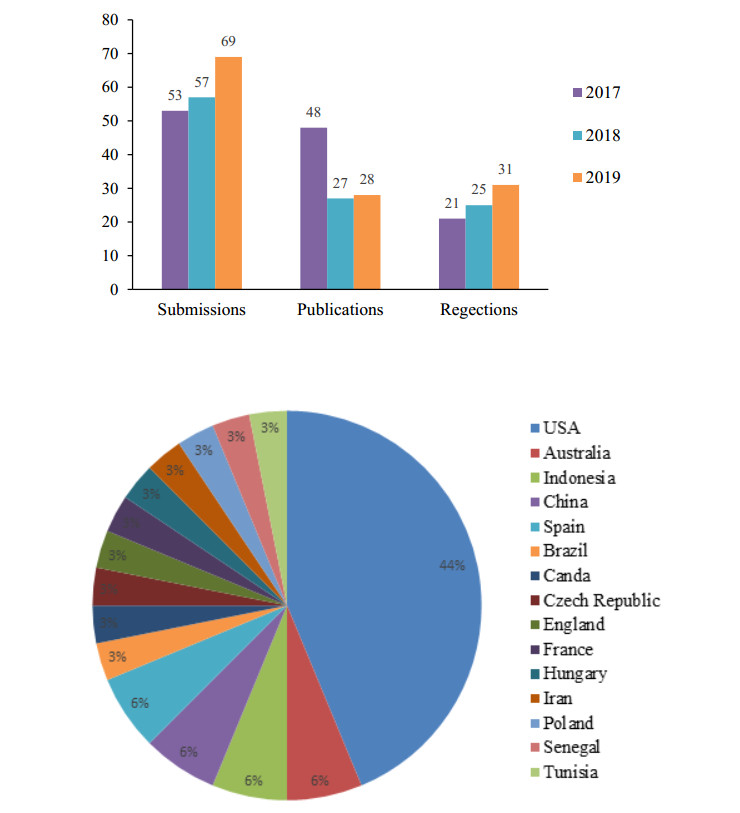









 DownLoad:
DownLoad:



